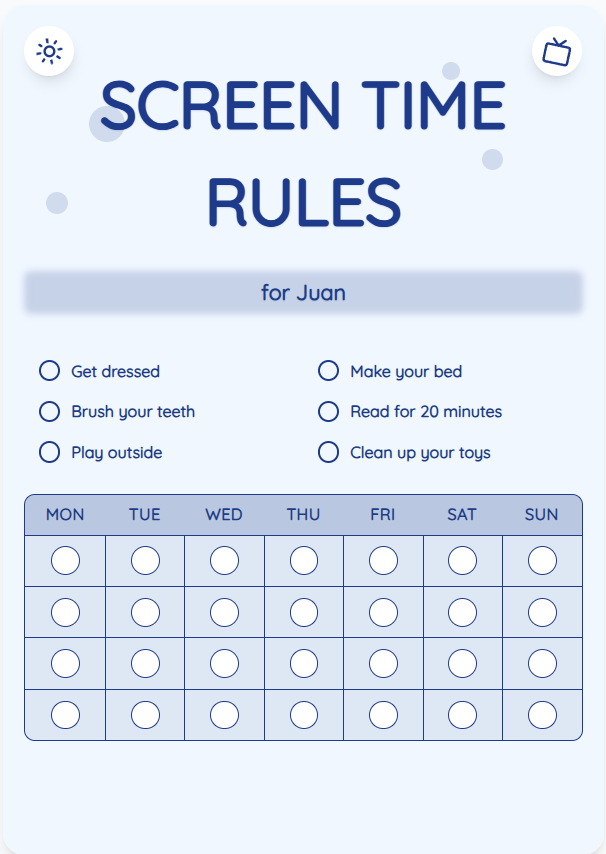Screen Time Hours: A Guide for Parents of Children Ages 2-12
As a parent, finding the right balance for screen time hours can be challenging. In this comprehensive guide, we provide practical advice and actionable tips to help you manage your child's screen time effectively while promoting healthy development and family harmony.
See What Your Screen Time Chart Will Look Like
Here's an example of a beautiful, customizable screen time rules chart you can create for your family

Understanding Screen Time Guidelines
Before diving into managing screen time, it's essential to understand the recommended guidelines. For children aged 2-5, the American Academy of Pediatrics suggests limiting screen time to one hour per day of high-quality programming. For older kids, aged 6-12, consistent limits and supervision are crucial.
Setting Clear Screen Time Rules
Establishing clear rules around screen time is key. Create a screen time chart using tools like ScreenTimeRules.com to visually represent daily limits. Involve your child in setting these rules to promote their understanding and cooperation.
Put These Tips Into Action
Create a custom chart to implement these strategies with your child
Promoting Alternative Activities
Encourage a healthy balance by promoting alternative activities such as outdoor play, reading, arts and crafts, or family bonding time. Setting a good example by limiting your own screen time can also positively influence your child's habits.
Monitoring and Adjusting Screen Time
Regularly monitor your child's screen time usage and be prepared to make adjustments as needed. Use screen time as a reward for completing chores or homework, and be consistent in enforcing the rules you've set.
Practical Tips for Success
- Create a visual screen time chart for easy reference
- Use parental control settings to manage screen time on devices
- Encourage outdoor play and physical activities as alternatives to screens
- Have designated screen-free zones in your home
Frequently Asked Questions
How can I handle resistance when enforcing screen time limits?
It's common for children to resist screen time limits, but consistency is key. Explain the reasons behind the rules and offer alternative activities to make the transition smoother.
Is it okay to use screen time as a reward?
Using screen time as a reward for positive behavior can be effective, but ensure it doesn't become the sole motivator. Balance rewards with other non-screen-related incentives.
What are the signs of excessive screen time?
Signs of excessive screen time include irritability when screens are taken away, difficulty focusing on non-screen activities, and disrupted sleep patterns. Monitor your child's behavior for these signs.
How can I encourage my child to self-regulate screen time?
Teach your child self-regulation by setting clear expectations and consequences around screen time. Encourage them to monitor their usage and take breaks to prevent excessive screen time.
By implementing these practical tips and strategies, you can effectively manage your child's screen time hours while promoting a healthy balance of activities. Remember, consistency and open communication are key in navigating screen time challenges. Visit ScreenTimeRules.com to create personalized screen time charts tailored to your family's needs.
Ready to Transform Your Family's Screen Time?
Join thousands of parents who have successfully managed screen time with our customizable charts.
